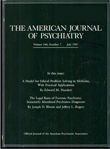Depression in medically ill hospitalized older adults: prevalence, characteristics, and course of symptoms according to six diagnostic schemes
Abstract
OBJECTIVE: The purpose of this study was to examine and compare rates of depression, correlates, and course of symptoms in medically ill hospitalized elders through use of six diagnostic schemes (inclusive, etiologic, exclusive-inclusive, exclusive-etiologic, substitutive- inclusive, and substitutive-etiologic). METHOD: A consecutive series of 460 cognitively unimpaired patients aged 60 or over who were admitted to the medical inpatient services of Duke Hospital underwent a structured psychiatric evaluation administered by a psychiatrist. Patients with depression were contacted by telephone at 12-week intervals after discharge to assess weekly change in depressive symptoms (median follow-up time = 47 weeks). RESULTS: The prevalence of major depression varied from 10% to 21% depending on diagnostic scheme; similarly, minor depression varied from 14% to 25%. Diagnostic strategy made little difference in known psychological and health characteristics of patients with depression (predictive validity) or severity of depressive symptoms (convergent validity). The diagnostic strategy that best distinguished a severe and persistent major depression was the exclusive-etiologic approach; however, this strategy missed 49% of patients with major depression identified by the inclusive approach, almost 60% of whom continued to experience persistent symptoms of depression many weeks after discharge. CONCLUSIONS: Diagnostic strategy affects rates of major and minor depression, with about a twofold difference between the extremes. There is little reason, however, to choose one diagnostic scheme over another in all cases. Diagnostic strategy should be chosen on the basis of the specific goals and purposes of the examiner. While the exclusive- etiologic approach identifies the most severe and persistent depressions, the inclusive approach is the most sensitive and reliable approach and is an intermediate predictor of persistent depression.



